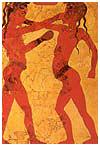 While
the origins of boxing are unknown, there have been recent
discoveries on the island of Crete that date back the
history of boxing to 1500 BC. While
the origins of boxing are unknown, there have been recent
discoveries on the island of Crete that date back the
history of boxing to 1500 BC.
Homer, the Greek poet describes a two-person fight in the
Iliad, as early as the epic poem's setting around 1800 BC.
Records indicate the sport was part of the ancient Olympic
Games of 688 BC.
Plato mentions boxing in both The Republic and the dialogue
Gorgias, and the poet Pindar elegized the Olympic boxing
champion of 474 BC.
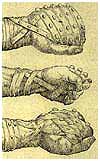 Along with running, wrestling, and the use of weapons,
boxing was part of a young man's education in ancient
Greece.
Along with running, wrestling, and the use of weapons,
boxing was part of a young man's education in ancient
Greece.
The Romans also embraced boxing, turning the sport into a
brutal gladiatorial spectacle.
Boxers of this time covered their hands and arms with a
leather thong called a cestus, sometimes studding it with
metal spikes. The combatants often fought until one was
fatally injured.
|
With the fall of the Roman Empire in the 5th century AD,
boxing seemed to disappear for hundreds of years, before the
restoration of English monarchy in 1660 relaxed moral codes
and allowed the sport with the barbaric history to make a
comeback.
 The
first mention of a staged fight came in an English newspaper
in 1681. Boxing as we know it began with the acknowledgement
of James Figg as first British heavyweight king in 1719.
Figg popularized sparring exhibitions and was responsible
for the opening of many amphitheaters. He died in 1740 and
was succeeded by his pupil, George Taylor who became the new
champ. The
first mention of a staged fight came in an English newspaper
in 1681. Boxing as we know it began with the acknowledgement
of James Figg as first British heavyweight king in 1719.
Figg popularized sparring exhibitions and was responsible
for the opening of many amphitheaters. He died in 1740 and
was succeeded by his pupil, George Taylor who became the new
champ.
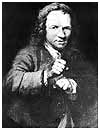 Taylor
was followed by the "father of boxing rules," Jack
Broughton, who in 1734 formulated the first code and
invented the boxing glove. Taylor
was followed by the "father of boxing rules," Jack
Broughton, who in 1734 formulated the first code and
invented the boxing glove.
Broughton's rules forbade hitting below the waist or hitting
an opponent who was down.
These regulations remained the standard in the sport until
the Revised London Prize Ring Rules of 1838 supplanted them.
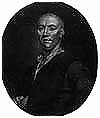 Soon after Broughton's retirement, British boxing was almost
at a standstill. As soon as Jack Slack became the new
champion, public lost its interest in boxing because of
charges of crookedness against the top fighters.
Soon after Broughton's retirement, British boxing was almost
at a standstill. As soon as Jack Slack became the new
champion, public lost its interest in boxing because of
charges of crookedness against the top fighters.
The next decade Slack dominated boxing until he faced Bill
Stevens "The Nailer" and lost his crown to the challenger on
June 17, 1760. From there on the title changed hands rather
quickly.
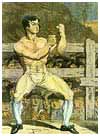 In 1838 a new code, The London Prize Ring Rules was adopted.
With the rise of the middle class and the influence of
reform and religious movements during the early 19th
century, public approval of boxing sagged again.
In 1838 a new code, The London Prize Ring Rules was adopted.
With the rise of the middle class and the influence of
reform and religious movements during the early 19th
century, public approval of boxing sagged again.
New anti prizefight laws were passed, police began stopping
fights, and judges prosecuted those involved. Many boxers
subsequently immigrated to the United States, hoping to find
greater boxing opportunities.
 The first heavyweight championship bout for the world title
took place on the morning of April 17, 1860, at Farnborough,
England. The contest was between the British champ Tom
Sayers and John Camel Heenan of America. After two hours and
twenty minutes of nonstop action, the bout ended in the
thirty-seventh round, as the crowd surged into the ring and
looting began. The referee ran away, as boxers continued to
fight for another five rounds. In the end, the world
championship fight ended in a draw with each fighter
receiving a championship belt.
The first heavyweight championship bout for the world title
took place on the morning of April 17, 1860, at Farnborough,
England. The contest was between the British champ Tom
Sayers and John Camel Heenan of America. After two hours and
twenty minutes of nonstop action, the bout ended in the
thirty-seventh round, as the crowd surged into the ring and
looting began. The referee ran away, as boxers continued to
fight for another five rounds. In the end, the world
championship fight ended in a draw with each fighter
receiving a championship belt. |

